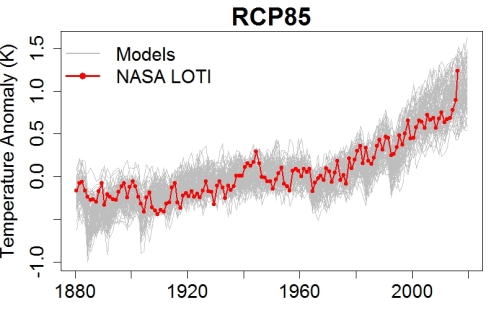A basic tent of physics is, the mass of an object is directly related to its energy storage potential.
But you said......"retention of heat doubles, not because of back radiation"
Is the water vapor somehow retaining heat without absorbing IR photons from the surface?
IN a wet atmosphere the LWIR is ABSORBED by water
Great. Now when this water vapor emits a photon, in which direction will it travel?
From observations we can say that CO2 has little to nothing to do with the process.
Why? Because it doesn't absorb photons, can't absorb photons, or it won't re-emit or won't re-emit toward the ground or it does emit toward the ground but somehow the photons never reach the ground?
WE know that water vapor (molecules) consumes most of its LWIR photons in its excited state to heat. Thus most of its absorbed LWIR photons are not re-emitted until it hits TOA
Instead of a fraction of a second for an IR photon to exit the atmosphere, it heats water vapor and the water vapor has to travel to the TOA before it releases a photon? How long does that take? Days, weeks, months?
Residency time is in minuets to hours. It is dependent on speed of air circulation and cloud boundary height. Water vapor only releases its photons when the vapor re-nucleates and forms droplets.
Residency time is in minuets to hours.
Water near the ground absorbs a photon and travels to the TOA in minutes?
I don't believe that.
Water vapor only releases its photons when the vapor re-nucleates and forms droplets
In which direction can the photon travel?
You forget the initial absorption at ground level. Then re-emitted to the atmosphere, at longer black body wavelengths, where it is either cascaded through certain molecules and out to space, Absorbed by others and then rises through the atmosphere as heated water and is then released to space, or is re-emitted towards the earth going back through the wall of molecules that would absorb and re-emit back towards space. The amount of energy that is actually reabsorbed by the ground is near zero during the day and negative at night.
Above about 3-5 meters the chances of photons reaching the ground in the LWIR wavelengths is near zero. At top of cloud boundary where water re-nucleates and LWIR is released those photons have zero chance at hitting the earths surface due to water vapor and clouds.
The range of residency time is from near zero when in the photon state and 3-5 hours ( time it takes water to rise to 30,000 feet through the air coulomb) in the heat state.
You forget the initial absorption at ground level
No I didn't. Not even once.
Then re-emitted to the atmosphere, at longer black body wavelengths, where it is either cascaded through certain molecules and out to space,
Straight out to space?
Or does some of the energy happen to be directed downward at any point during this process?
Absorbed by others and then rises through the atmosphere as heated water and is then released to space,
Why only to space?
The amount of energy that is actually reabsorbed by the ground is near zero during the day and negative at night
Why? Magic energy shield at ground level?
Above about 3-5 meters the chances of photons reaching the ground in the LWIR wavelengths is near zero.
Why?
No, there is no magic shield. What there is however is the absorptive properties of the surface and the fact that atmosphere above it is cooler. Warming caused by the cooler can not happen without energy use.
Which leads us to your last question about why only 3-5 meters above the earth..? The word is CONDUCTION. As air rolls in this lower section of the atmosphere its direct contact and radiateive flow is to the cooler atmosphere.
The AGW hypothesis is that CO2 trapping LWIR is fully responsible for the warming of the near surface atmosphere. Yet they ignore the very basics of physics and natural process that fully explains the warming that we have seen.
The absence of a mid tropospheric hot spot is evidence that CO2 is not down ward radiating (actually any direction) enough to create heat build up in water vapor. The only potential heat increase is near surface where it directly affects the ground during the day.
Lets look at why anything above 5 meters has a very low probability of affecting the surface. Look at the deserts at night. They have virtually the same levels of CO2 as the rest of the planet yet at night, just after dusk, as the ground is radiating at its greatest, CO2 it is incapable of retaining the heat. It releases heat at a rate 3 times faster than an atmosphere of 30% humidity because LWIR is not stopped or slowed by CO2 alone in our open atmosphere.
IF a photon is released towards the ground and it is intercepted by another molecule does that molecule have to re-emit it back towards ground or can it emit it towards space? As the altitude of the molecule grows from the ground the chances a photon can be re-emitted towards the ground become less and less. The laws of probability become near zero at just five meters at levels of 1000ppm. At our current level of 400ppm its less than that.
